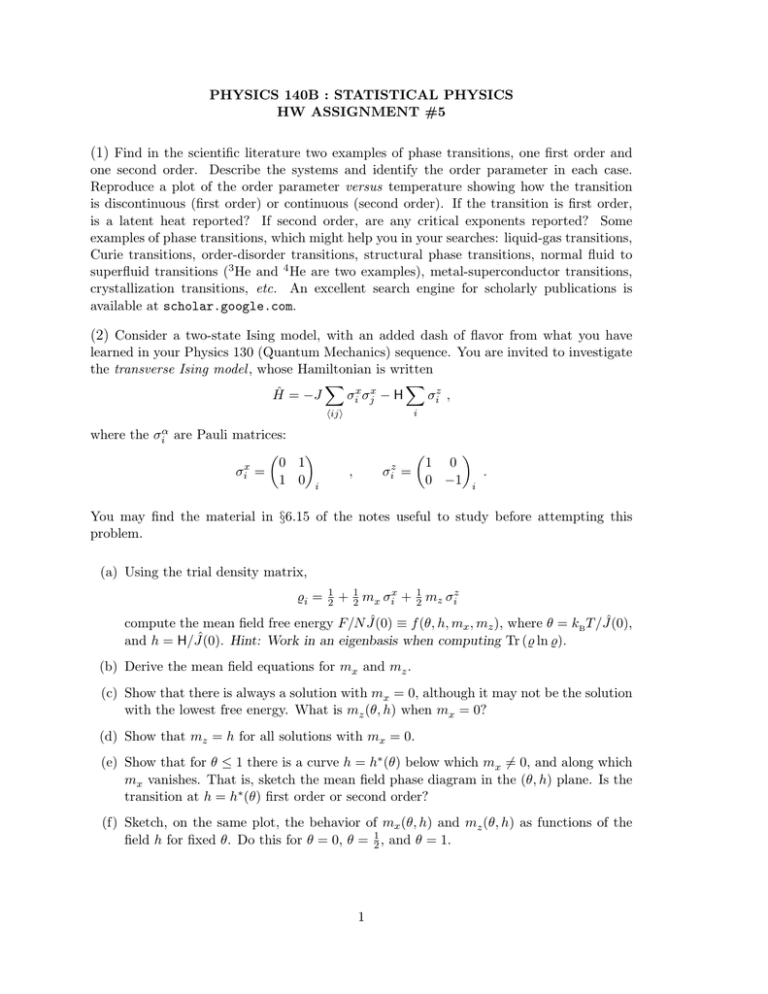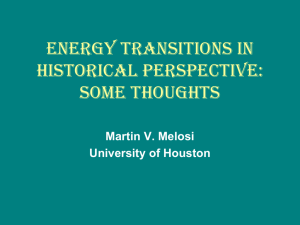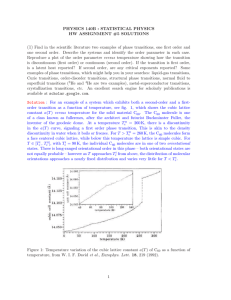(1)
advertisement

PHYSICS 140B : STATISTICAL PHYSICS HW ASSIGNMENT #5 (1) Find in the scientific literature two examples of phase transitions, one first order and one second order. Describe the systems and identify the order parameter in each case. Reproduce a plot of the order parameter versus temperature showing how the transition is discontinuous (first order) or continuous (second order). If the transition is first order, is a latent heat reported? If second order, are any critical exponents reported? Some examples of phase transitions, which might help you in your searches: liquid-gas transitions, Curie transitions, order-disorder transitions, structural phase transitions, normal fluid to superfluid transitions (3 He and 4 He are two examples), metal-superconductor transitions, crystallization transitions, etc. An excellent search engine for scholarly publications is available at scholar.google.com. (2) Consider a two-state Ising model, with an added dash of flavor from what you have learned in your Physics 130 (Quantum Mechanics) sequence. You are invited to investigate the transverse Ising model , whose Hamiltonian is written X X Ĥ = −J σix σjx − H σiz , i hiji where the σiα are Pauli matrices: 0 1 x σi = 1 0 i σiz , = 1 0 . 0 −1 i You may find the material in §6.15 of the notes useful to study before attempting this problem. (a) Using the trial density matrix, %i = 1 2 + 12 mx σix + 12 mz σiz ˆ ≡ f (θ, h, mx , mz ), where θ = k T /J(0), ˆ compute the mean field free energy F/N J(0) B ˆ and h = H/J(0). Hint: Work in an eigenbasis when computing Tr (% ln %). (b) Derive the mean field equations for mx and mz . (c) Show that there is always a solution with mx = 0, although it may not be the solution with the lowest free energy. What is mz (θ, h) when mx = 0? (d) Show that mz = h for all solutions with mx = 0. (e) Show that for θ ≤ 1 there is a curve h = h∗ (θ) below which mx 6= 0, and along which mx vanishes. That is, sketch the mean field phase diagram in the (θ, h) plane. Is the transition at h = h∗ (θ) first order or second order? (f) Sketch, on the same plot, the behavior of mx (θ, h) and mz (θ, h) as functions of the field h for fixed θ. Do this for θ = 0, θ = 21 , and θ = 1. 1 (3) Consider the U(1) Ginsburg-Landau theory with Z F = ddx̃ h 2 1 2 a |Ψ| i ˜ 2 . + 41 b |Ψ|4 + 12 κ |∇Ψ| Here Ψ(x̃) is a complex-valued field, and both b and κ are positive. This theory is appropriate for describing the transition to superfluidity. The order parameter is hΨ(x̃)i. Note that the free energy is a functional of the two independent fields Ψ(x̃) and Ψ∗ (x̃), where Ψ∗ is the complex conjugate of Ψ. Alternatively, one can consider F a functional of the real and imaginary parts of Ψ. (a) Show that one can rescale the field Ψ and the coordinates x̃ so that the free energy can be written in the form Z h i F = ε0 ddx ± 21 |ψ|2 + 14 |ψ|4 + 12 |∇ψ|2 , where ψ and x are dimensionless, ε0 has dimensions of energy, and where the sign on the first term on the RHS is sgn (a). Find ε0 and the relations between Ψ and ψ and between x̃ and x. (b) By extremizing the functional F [ψ, ψ ∗ ] with respect to ψ ∗ , find a partial differential equation describing the behavior of the order parameter field ψ(x). (c) Consider a two-dimensional system (d = 2) and let a < 0 (i.e. T < Tc ). Consider the case where ψ(x) describe a vortex configuration: ψ(x) = f (r) eiφ , where (r, φ) are two-dimensional polar coordinates. Find the ordinary differential equation for f (r) which extremizes F . (d) Show that the free energy, up to a constant, may be written as " ZR 2 f2 F = 2πε0 dr r 21 f 0 + 2 + 2r # 1 4 1−f 2 2 , 0 where R is the radius of the system, which we presume is confined to a disk. Consider a trial solution for f (r) of the form f (r) = √ r2 r , + a2 where a is the variational parameter. Compute F (a, R) in the limit R → ∞ and extremize with respect to a to find the optimum value of a within this variational class of functions. 2






